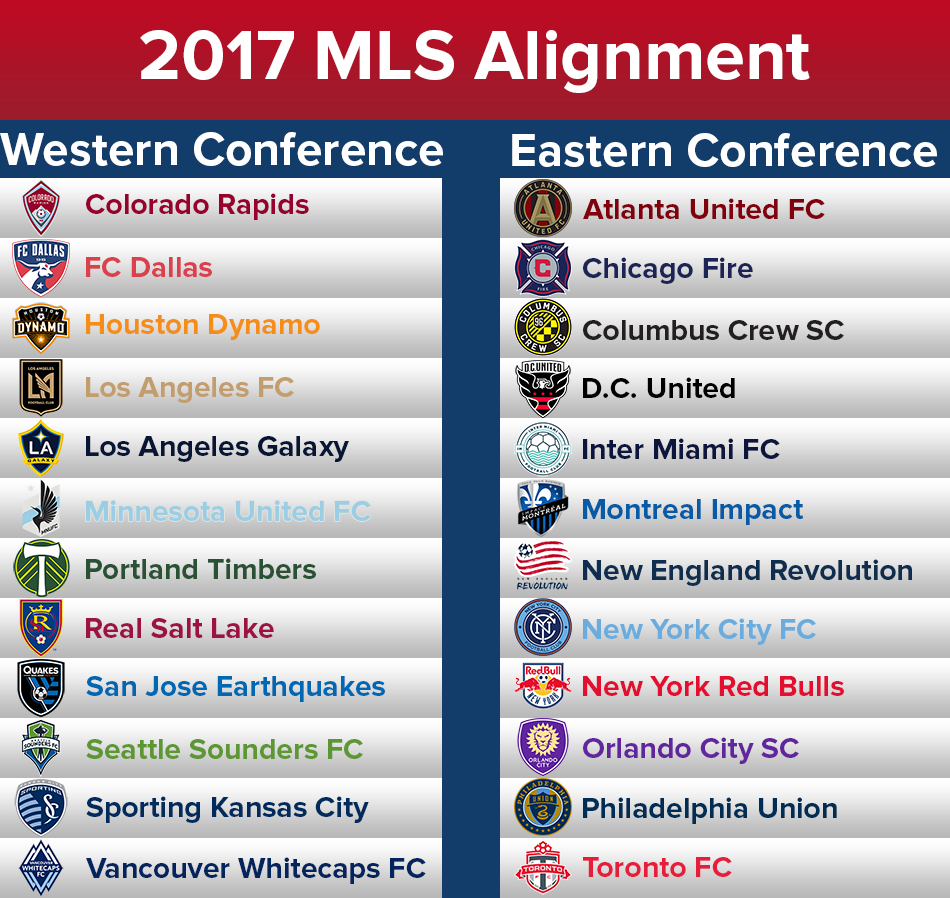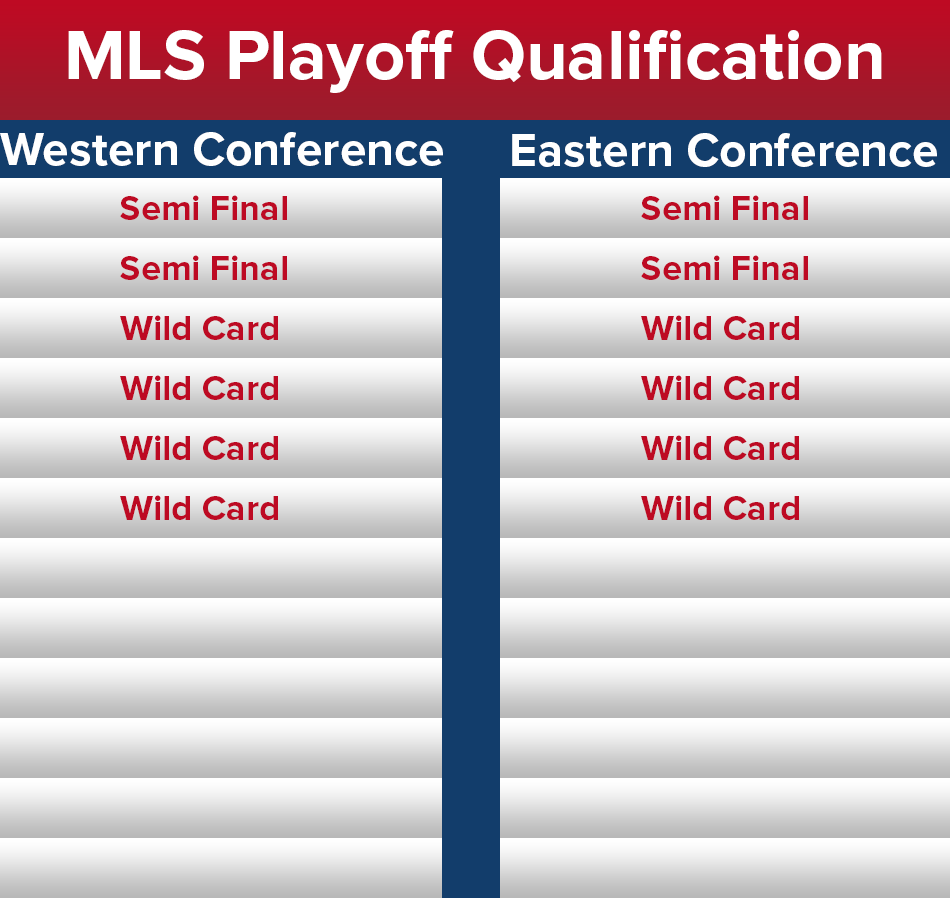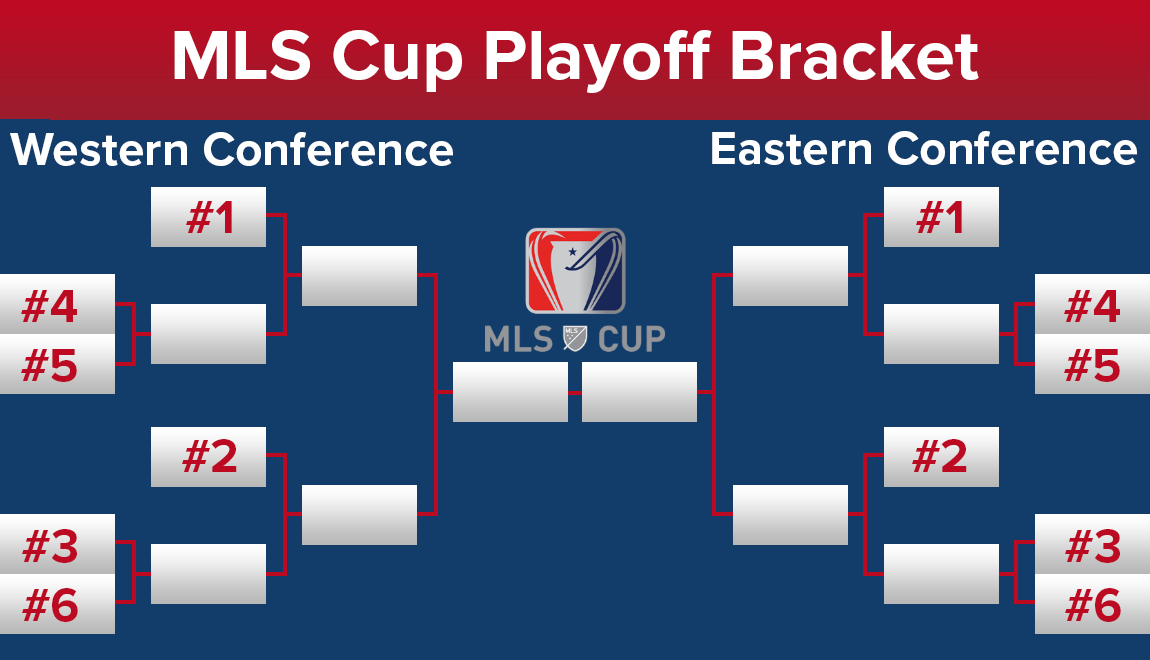Want to write for our blog? Get in touch about becoming a sortitoutsi writer.
So let’s begin by looking at the basics.

In 2016 MLS is made up of 20 teams, split into two conferences of 10, East and West. In 2017 the league expands to 22 teams (11 in each conference with the addition of Atlanta United and Minnesota United). My file also adds future expansion teams Miami and Los Angeles FC (24 total, 12 in each conference). Here is how the league lays out when the game starts in 2016:

And this is the default alignment in 2017:

And this is 2017 with my edited DB file:

The league plays a 34-match regular season. In 2016, This means that you will play everyone in your conference twice plus 6 randomly selected opponents (24) and every team in the other conference once (10). In the default 2017, you play opponents in your conference twice plus three random opponents (23) and each team in the other conference once (11). In my file, you play every team in your conference twice (22) and each team in the other conference once (12). The schedule runs from the first weekend in March to the last weekend in October.
The team with the overall most points regardless of conference wins what is called the MLS Supporters Shield, and automatically qualifies for the CONCACAF Champions League regardless of performance in the MLS Playoffs. It should also be noted that as an American sport, there is no promotion or relegation.
The transfer windows run from 14 February to 8 May, and 10 July to 9 August. There are obviously a ton of confusing rules about how MLS “transfers” work, but we’ll cover that in a later post.
So in most European leagues, the champion is decided by the performance in a simple double round-robin competition. Here in the United States, our sports fans expect the champion to be decided by a playoff. Whether you agree or disagree, that’s how it is.
So how do teams qualify for the MLS Cup playoffs? The top two teams in each conference automatically qualify for the Conference Semifinals, while the teams that finish 3rd-6th participate in what is called the Wild Card round to advance to the Semi Final.

And here is an image of how the brackets layout:

Wildcard: One Leg at the higher seed
Conference Semifinal & Final: Two Legs, with the second leg played at the higher seed.
MLS Cup Final: Played at the home stadium of the team who had the most points during the regular season.

The national cup for the United States if the Lamar Hunt U.S. Open Cup. The cup is open to amatuer, semi pro, and professional clubs. MLS teams enter the competition in the 4th round in June when most amatuer teams have been eliminated. The Cup squad can only have five international players on it. While the competition does not have a very high reputation and most MLS clubs send reserve teams until the final/semi final, the winner of the competition earns automatic qualification to the CONCACAF Champions League.
So that is the format. In the next post I’ll start the game and dive into what the different types of contract designations mean.

Alignment
In 2016 MLS is made up of 20 teams, split into two conferences of 10, East and West. In 2017 the league expands to 22 teams (11 in each conference with the addition of Atlanta United and Minnesota United). My file also adds future expansion teams Miami and Los Angeles FC (24 total, 12 in each conference). Here is how the league lays out when the game starts in 2016:

And this is the default alignment in 2017:

And this is 2017 with my edited DB file:

Regular Season
The league plays a 34-match regular season. In 2016, This means that you will play everyone in your conference twice plus 6 randomly selected opponents (24) and every team in the other conference once (10). In the default 2017, you play opponents in your conference twice plus three random opponents (23) and each team in the other conference once (11). In my file, you play every team in your conference twice (22) and each team in the other conference once (12). The schedule runs from the first weekend in March to the last weekend in October.
The team with the overall most points regardless of conference wins what is called the MLS Supporters Shield, and automatically qualifies for the CONCACAF Champions League regardless of performance in the MLS Playoffs. It should also be noted that as an American sport, there is no promotion or relegation.
The transfer windows run from 14 February to 8 May, and 10 July to 9 August. There are obviously a ton of confusing rules about how MLS “transfers” work, but we’ll cover that in a later post.
Playoffs
So in most European leagues, the champion is decided by the performance in a simple double round-robin competition. Here in the United States, our sports fans expect the champion to be decided by a playoff. Whether you agree or disagree, that’s how it is.
So how do teams qualify for the MLS Cup playoffs? The top two teams in each conference automatically qualify for the Conference Semifinals, while the teams that finish 3rd-6th participate in what is called the Wild Card round to advance to the Semi Final.

And here is an image of how the brackets layout:

Wildcard: One Leg at the higher seed
Conference Semifinal & Final: Two Legs, with the second leg played at the higher seed.
MLS Cup Final: Played at the home stadium of the team who had the most points during the regular season.

The national cup for the United States if the Lamar Hunt U.S. Open Cup. The cup is open to amatuer, semi pro, and professional clubs. MLS teams enter the competition in the 4th round in June when most amatuer teams have been eliminated. The Cup squad can only have five international players on it. While the competition does not have a very high reputation and most MLS clubs send reserve teams until the final/semi final, the winner of the competition earns automatic qualification to the CONCACAF Champions League.
Conclusion
So that is the format. In the next post I’ll start the game and dive into what the different types of contract designations mean.
Comments
You'll need to Login to comment
Uncle Sam
So let’s start with the Senior Roster. These slots count against the Salary Cap, which in the beginning of the game is $3,650,000 per year. That will go up slightly every season in-game. I believe the second year it’s $3,840,000, but that may not be accurate.
Your Senior Squad will obviously have your Senior players. Your Designated Players (DP) will also be counted in your Senior Squad. If your DPs and Senior players don’t add up to a total of 20, then the remain slots will be filled with Senior Minimum Salary (SMS) contracted players. So, for example, let’s say that I have 3 DPs and 15 Senior players, that means that if I have 2 on SMS contracts, they will count against the cap also to round out the 20.
I’m using this “First 20 slots” phrase to make it easier to understand, but the truth is that you can have more than 20 slots filled on your Senior Squad. For example, if I have 3 DPs and 19 Senior players, then all 22 of those players will count against the Salary Cap. It also means that I would only have 6 slots available for the Off-Budget squad. You can also actually not have all 20 slots filled. If I have 3 DPs, 15 Senior players, and no one on SMS contract, then I will only 18 on the Senior squad. It also means that the most I can have on my squad is a total of 26 as you can only have a maximum of 8 on your Off-Budget squad.
The Off-Budget roster does not count against the Salary Cap. Your Off-Budget Squad can only have 8 players. Players on the Off-Budget squad are those on Reserve Contracts (maximum 6) and any SMS players that are not included on the Senior squad. The Off-Budget squad can also include players that were designated as Generation Adidas players going into the SuperDraft.
It might help to understand the history of the Designated Player. As MLS started becoming more successful, some team owners wanted to be able to acquire higher profile players that could make their teams better, and increase the visibility of their brand. Early in its existence it became known as the “David Beckham rule”, as it allowed the LA Galaxy to make Beckham the first Designated Player. The problem with acquiring these players is that salary cap prevented the teams from being able to offer them a contract that fit in the cap. The Galaxy were not going to sign David Beckham at $300k a year. Many of these players would need contracts exceeding the entire amount allowed for an entire team.
So the idea was to allow clubs to “break the salary cap” for two players. It would help the teams, and it would help the league. In order to maintain fiscal responsibility, the teams themselves would be responsible for the salary of Designated Players, whereas the league itself pays the salaries of all other players. So a team can pay a player $7M a year, but it will only count as $435,000 against the salary cap.
Eventually, some teams wanted to use their DP slots on younger players and MLS wanted to encourage youth development. So they created the idea of “Young Designated Players” (YDP). For DPs under 23, they reduced the impact on the salary cap.
So what does that mean for FM gamers? Well from a functional standpoint, it adds a little to scouting. You can now scout international youth players with the idea that you are not limited by the Wage Maximum. You will also occasionally be approached by high profile players who want to be signed on a Designated Player contract. Just as an example, in one of my games I had Dani Alves and Lucas (Arsenal) on my squad. You can also approach players who are almost or fully out of contract and offer them DP contracts.
Senior players will make up the largest part of your squad. Players signed to Senior contracts can make no more than $363,000 per year. Their salaries will count fully against the salary cap, although you will be able to use Allocation Money to “buy down” the impact of their salary against the cap. We will cover that later. Because their salaries will count fully against the cap, these players will be on the Senior Squad.
Players who are paid the league minimum salary of $60,000 are called SMS players. Whether or not these players count against the cap depends on how many DPs and Senior players who have on the squad. I already covered how that works earlier, but basically SMS players round out the numbers if your Senior squad has less than 20 players. Any SMS players you have after the Senior squad has been filled out will be put on the Off-Budget squad and their salary will not count against the cap.
The title of this contract type is probably confusing. It should be said that MLS does not have a Reserve League (anymore). Players registered as Reserve Players simply have a contract below the Senior Minimum Salary, are 24 years old or younger, and are NOT Generation Adidas players. Reserve players are on your Off-Budget squad and therefore do not count against the cap. Most of these contracts are given to players that are drafted in the later rounds and therefore do not demand a high salary. You don’t have to have any Reserve players, however the most you can have is 6.
As you might already know, college sports in the United States is very popular. In our country the path for professional sports goes through college. If a high school players is good enough, then a college team will offer them a scholarship so that they can play their sport while also attending class for free. However, in order for these players to maintain their amatuer status and remain eligible for their college team, they could not receive any compensation relating to their play (being paid to play, endorsements, merchandise, etc.). In the early days of MLS, the salaries were far too low to entice players to surrender their eligibility for their college teams. Teams did not want to risk giving up a lot of their salary cap space on players that had never played professionally before.
That’s when MLS created the Generation Adidas program (originally called Project-40). Every year, clubs make recommendations to MLS for offering Generation Adidas contracts to specific college players, and usually 12 are selected (although not all players sign the contract and choose to play overseas). The GA contracts are higher than the typical MLS rookie, which encourages players to leave or even forgo entirely their college team and enter the more challenging environment of professional soccer in the hopes that it will help their development. The league also stores money in an escrow account so that if the player’s career doesn’t work out, they can go back to school and finish their degree. GA contracts also do not count towards the team salary cap, so that entices the clubs to take a risk.
In Football Manager, the risk factor of drafting a GA player is accurately reflected. Most of the best players will be GA, however not all GA players will be league stars. Jozy Altidore, Michael Bradley, and Clint Dempsey were all Generation Adidas players. However, there are a lot of GA players who didn’t make it in the league. So while GA players aren’t going to hurt your salary cap, you can’t assume that they will be future national team quality just because they’re GA.
Next I’ll cover how MLS handles international players. The easiest way to look at it is that every team starts with 8 International Player slots. In reality, there are a total of 160 International Slots (176 in 2017, or with my file 192 in 2017) that have been distributed to the MLS teams. These International Slots are actually exchangeable assets. MLS clubs can choose to trade these slots to other teams as part of domestic transfers. MLS teams can trade an international slot for 1, 2, 3, 4 or 5 years, after which they will revert back. International Slots can also be traded on a permanent basis.
In the mid-2000’s MLS started getting pressured to take an active role in developing their own talent. The league implemented a rule that stated every MLS club must operate their own Academy. Some clubs take it more seriously than others, and that’s reflected in the game in their Youth Facilities, Coaching, and Recruitment ratings.
Next the league had to sort out how to handle signing homegrown players. In the beginning the clubs were only allowed to sign a certain number of players from their Academy per year, but that discouraged the teams from investing in their Academy program. Now the clubs may sign as many Academy players as they want.
In FM, the truth is that your Academy will not produce many stars, but you can usually sign 2-3 or potential contributors per year. Most of the time they won’t be able to step in right away, but given some time to develop they could eventually be starters. This is actually true to life, as it is very rare that a Homegrown signing walks into the first team immediately.
So above is a Sample of how a full MLS squad might look. In the example above, you have:
-3 Designated Players (with one Young DP)
-16 Senior contract players (with 1 on the Off-Budget squad because they are a Generation Adidas player)
-3 Senior Minimum Salary players (2 on the Senior squad, 1 on the Off-Budget squad)
-6 Reserve contract players.
-You have 1 Homegrown on the Senior squad, and 1 on the Off-Budget. That illustrates that Homegrown players on Senior contracts will count against the cap.
-7 International players on the Senior squad, and 1 on the Off-Budget squad because they have a Senior Minimum Salary and the Senior squad is full with 20 players, so they will not count against the cap.
Obviously, this will all be a bit confusing to an outsider. I don’t expect that reading this will make you fully understand it. However, using it as a reference as you play the game will help as you assemble your squad. It should also be said that each year the Salary Cap, Wage Maximums, Wage Minimums, etc., will likely go up. That is an accurate reflection of real life.
Next I will look at how you go about acquiring players in MLS.
Uncle Sam
Before I dive in to each method, let me explain the unique structure of the league. First of all, MLS is what is called a "Single Entity". Rather a league made up of 20-24 independent clubs, it is One Corporation with 20-24 sub-franchises. The league itself actually owns ALL of the player contracts. So when a foreign club wants to purchase a player, they negotiate a transfer fee with the league office, not the club that the player plays for. So when clubs within the league negotiate trades, they're really bargaining with the league's property rather than their own. This might help you to understand allocation money, which we'll cover towards the end.
Probably the best way to think of the Trade process is to consider it domestic transfers between teams in MLS. This is simply the swapping of players and/or other assets. When two MLS clubs negotiate a trade, they have several assets that they can offer.
General Allocation Money - Think of this as your domestic transfer budget. We will cover Allocation money more towards the end of this post.
Current Players - Any player on your current MLS squad, besides those that you have loaned in from other clubs.
SuperDraft Picks - One relatively valuable asset that clubs have are picks in the annual MLS SuperDraft that takes place every January.
International Slots - MLS clubs can actually swap the number of foreign player slots that they have available.
-Player Rights - When an MLS team loses a player to a foreign club before their contract is up, they retain the rights to that player should they return to the league. These rights are another asset that clubs use when negotiating a trade.
The Discovery Signing category essentially covers all player acquisitions from foreign clubs, whether it be transfers or loans. Transfer fees for Discovery Signings will come out of your club transfer budget, which is probably the most "normal" process in MLS on Football Manager. Your team will be allowed to make six discovery signings per season, although I have found that for most clubs all of the 2016 Discovery Signings have already been made so you might not be able to make any until the second season (2017).
Homegrown signings are simply players that you sign from your Academy team. You can sign as many Homegrown players as you want, and they maintain their status until they leave your club.
Free Transfers in MLS are not much different than in other leagues. The main exception is that if the player is based in a foreign country, they will count as one of your Discovery Signings. Also, if you attempt to sign a player whose rights are held by another MLS club, then you must negotiate a Trade to acquire those player rights.
In the rest of the world, when a club wants to drop a player they have to "release them on a free transfer". When an MLS team wants to release a player, the process is referred to as "Waivers". It's a common practice in American sports where the team makes the player's contract available to other teams. When a team claims a player off of the Waiver Wire they are assuming the terms of the contract that the player had signed with the previous club.
After a team has placed a player on Waivers, the other MLS teams have two days to make a claim. After the time is us up and all of the claims are in, the team that is highest on the Waiver Order gets the player. The Waiver Order is determined by how the teams performed the previous season, with the team that had the fewest points having the highest priority and the MLS Cup winner having the lowest. If no team claims the player before the two days are up, then player is released and is free to negotiate a new contract.
In American sports the College Draft concept is one of the mechanisms used to try and maintain competitive balance. Rather than allowing players who graduate college, leave college early, or choose to skip college altogether sign for whichever team that they want, the league reverses the table from the previous season and allow the teams to select the player they want to sign in that order. The idea is that the worst teams get first choice of the best players entering the league out of college.
The MLS draft consists of four rounds, which each team getting one selection in each round. As we have already stated, draft picks are a transferable asset that can be used in trades. In FM17, you can actually make trades for picks DURING the draft, which is a nice addition that mimics real life. The Draft itself takes place in the middle of January, right as the preseason is about to start.
Certainly the draft is going to be more of a hit-or-miss prospect than scouting and signing an international player. Several players in the draft will never get much better than they are when you select them. However, there are some high potential players in the draft and it would be a mistake to dismiss it entirely. You will get a news alert informing you that players have been selected for the SuperDraft and the option to scout a few of them. There is also an MLS Draft Combine where about 70 of the 120 or so players are divided into four teams and they play a round robin competition. For good measure, I go to the squads of the four Combine teams and select all of the players and have my scouts assemble reports, so that I am as prepared as possible for the SuperDraft.
At the end of the season, MLS gives players whose contracts are expiring the option to enter Re-Entry Draft. It functions much the same as the SuperDraft, with the Order basically being a reversal of the seasons table. Some players will reject the Re-Entry Draft and instead choose to leave MLS. There will occasionally be some talented players in the Re-Entry Draft that clubs were forced to let go due to financial or squad registration issues.
After the squad registration, there are usually a lot of players that have been waived because teams chose not include them on their 28-man squad for whatever reason. The league's answer to all of these players suddenly being placed on the Waiver Wire was to hold a draft. The players who aren't selected in this draft are granted a free transfer. As with the other drafts, the Waiver Draft order is a reverse of the previous season's table.
There are often some high quality players that teams simply couldn't fit on their squad. I will often leave a space or two open going into the draft by loaning players out to an affiliate. If it turns out that I don't like any of the players in the Waiver Draft, then I can simply recall those players off loan.
And one bonus method of acquiring players: The Expansion Draft. MLS expands in 2017 to 22 clubs (or 24 in my database file). One of the mechanisms employed by the league to help expansion teams start with a competitive squad was to allow them to cherry-pick players from the existing MLS teams.
The way that the process works is that the existing MLS teams are allowed to protect 11 players from their current squad. This list must include players that they have loaned in and Homegrown players. The 2 expansion teams (or 4 in my file) will then hold a draft where they are free to choose from all of the players in MLS that the teams have not protected. The draft consists of five rounds with each expansion team getting one pick per round. To prevent an MLS team from losing half of its squad, no existing MLS team can have more than one player taken in the expansion draft. So for example, if the LA Galaxy have a player taken with the first pick, then no more Galaxy players can be chosen in the draft.
Obviously the expansion draft will only be open to the expansion teams. So if you play as Atlanta United or Minnesota United, then you will take part. Unfortunately, due to limitations with the editor, then that is even true with my database file as you will be unable to control LAFC or Inter Miami.
What is this "Allocation Money" that you keep seeing in MLS games? The best way that I can think of to describe it is to imagine that you are playing a board game with friends that involves "play money", like Monopoly. The players all sit around the board and the banker distributes the money and the players use that money to play the game. In Monopoly, players can use the play money to go and buy properties, houses, and hotels on the board. They can't, however, take that play money and spend it anywhere else.
That is essentially what allocation money is in MLS. The clubs can use the allocation money to perform functions within the league, but they can't go and buy players from foreign clubs with it because it might as well be Monopoly money to them.
So how can you actually use allocation money? You must first know that there are two kinds of Allocation Money: General and Targeted. Both are very valuable in their own way. Both types of Allocation Money can be used in trade negotiations with other MLS clubs. They both also help you to manipulate your contract salary cap impacts, allowing to improve the overall quality of your squad.
General Allocation Money can be used as Agent fees and Signing On bonuses in contract negotiations. Where it is really helpful, however, is that you can use General Allocation money to "buy down" the impact of a Senior Player's salary cap impact. So let's say you're going to be over the Salary Cap. If you have enough General Allocation Money you can go to the "Contract Info" of one of your higher earning Senior Players, and there you will see the option to slide his salary cap impact down. How far you can go is determined by how much General Allocation money that you have. You can reduce a Designated Player's salary down to $150,000 with General Allocation Money.
So how do you get General Allocation Money? First of all the league gives you a $200,000 allowance every season. There are also several ways to earn it. One way that you do not want to earn it is by missing the MLS playoffs. While you receive $200,000 of Allocation Money, you will also likely be sacked. You also receive allocation money by achieving one of the methods for qualifying for the CONCACAF Champions League, whether it be winning the US Open Cup, winning the MLS Cup, winning the MLS Supporters Shield, or performance overall, you will get $200,000 of General Allocation Money. You can also earn another $100,000 in General Allocation Money by advancing out of the group stage of the CONCACAF Champions League.
Probably the best way to earn General Allocation Money is by selling players to foreign clubs. While the league gets a significant portion of transfer fees, much of it is distributed back to the team though General Allocation Money. By developing and selling players for high fees, you can really increase your ability to sign quality players and maintain a strong squad.
The only method for receiving Target Allocation Money is the allowance distributed by the league at the beginning of every season, starting with the second season (2017). Targeted Allocation serves two helpful functions. First of all, it can allow to convert a Designated Player to a Senior Contract player. If you have Three Designated Players, then this can essentially help you to go and get a fourth. It can also help you to sign a player who is demanding a contract that is above the Maximum Wage. It's also useless not to use the Targeted Allocation Money that the league gives you, because they take it all back at the end of the season.
So that's how the player acquisition process works in MLS. Obviously it's a lot more complicated than the simple scout-and-buy process you see in most of the leagues around the world. I enjoy the challenge, and I actually think that it makes me a better squad builder when I do manage in other leagues.